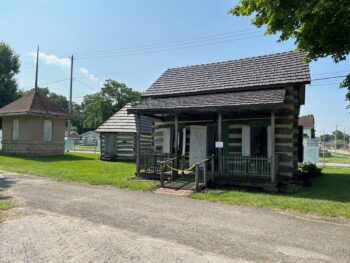
Walking among the animal barns and the Midway at the Marion County Fair, visitors can step back into history. The Wilhelm-Seiter Log Cabin and the Conrad Neidhardt Smokehouse at the offer a glimpse at life in Marion in the 1800s.
Jeff Thatcher of Cardington remembers helping move the cabin from its original location on Seiter Road in Big Island Township, six mile west of the fairgrounds. The cabin was constructed the same year as the first Marion County Fair: 1851.
“I knew Carroll Neidhardt and his brother, Rich Dune. Carroll labeled all of the logs and we took it apart and reassembled it here,” Thatcher said.
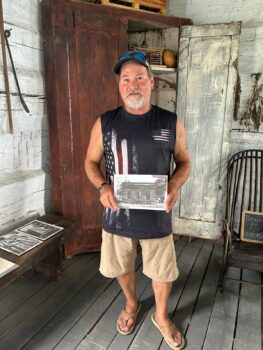
Thatcher was among the students from Ridgedale who spent years on the project. The Carl Seiter family donated it to the Marion County Historical Society in 1978. It took two years to dismantle it and move it to the fairgrounds. Once the logs were in place, the cabin was “chinked,” or plastered, in 1981. The porch was added in 1982.
Once complete, Thatcher recalls many of the boys staying at the county fair all week and sleeping in the loft inside the cabin.
“It was a lot of fun!” Thatcher said.
The cabin is decorated with furniture from the 1850s, including many original pieces. Volunteer Daryl Greashaber of Marion portrays Jacob Howser, a prominent local businessman of the era. Howser was a member of the agricultural board that put on the county fair. Howser was born in 1812.
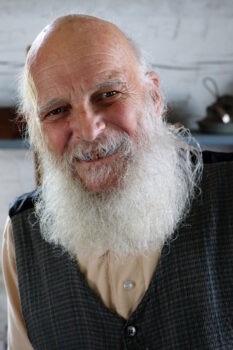
“I’m looking pretty good for 211!” Greashaber chuckled.
Greashaber enjoys imagining what life was like and helping visitors picture it, too.
“Eleven people used to live here,” Greashaber said.
The original structure did have an addition with a kitchen, but it would still be crowded.
“One girl came through and saw the closet and said her clothes wouldn’t fit in it. I said that was the only closet for the entire family,” Greashaber said. “People probably only had one or two sets of everyday clothes and one for Sundays.”
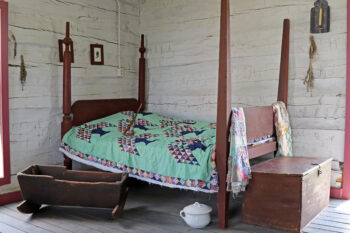
The display includes a butter churn, spinning wheel and chamber pot. Ropes hold the mattress above the floor. A dry wooden sink is in the corner.
“You had to use water sparingly for washing vegetables, plates and clothes. The wood would warp if it was wet for too long,” Greashaber said.
Other items are still used today, including the teapot, rocking chair, wooden spoons, rolling pin and a checkerboard. Candlelight provided an opportunity to read in the evenings.
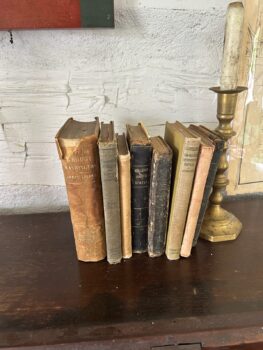
“People probably read more as there were fewer distractions,” said Greashaber, an avid reader himself. “Things might have been simpler, but they might have been better in some ways.”
Next door stands the 1831 Conrad Neidhardt Smokehouse, which was donated by the Robert Lehner family of Pleasant Township in 1982.
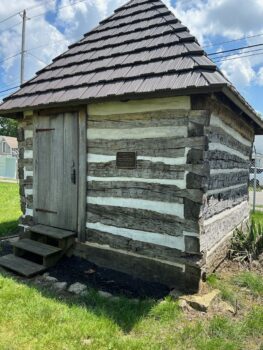
“I’ve always been interested in history. I’ve done this for five years. My daughter volunteered to play one of Jacob Howser’s children, for several years,” Greashaber said. “We’ve also volunteered together at the Night at the Museum.”
Greashaber also performed with the Ohio 9th Light Artillery Battery reenactors at Veterans Park in Marion on Memorial Day.
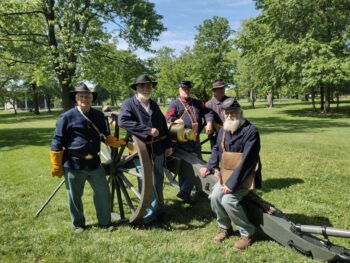
“I’ve always been curious,” Greashaber said.
Greashaber pointed out the brick ticket office next to the smokehouse.
“There used to be an electric interurban railway. You could catch a ride to Columbus, Mansfield, or Bucyrus.”
The railway operated in the early 1900s but Greashaber said it stopped running in Marion about 1933.
Greashaber came to Marion as a teenager in 1968 and noted the changes he has witnessed over the decades.
“I tell people to pay attention. Marion is changing all of the time. It’s amazing that 50 years go by and it’s a lot different than it was today,” Greashaber said.
For more about Marion history or volunteer opportunities, contact the Marion County Historical Society at (740) 387-4255, email mchs@marionhistory.com, or go to www.marionhistory.com.


















